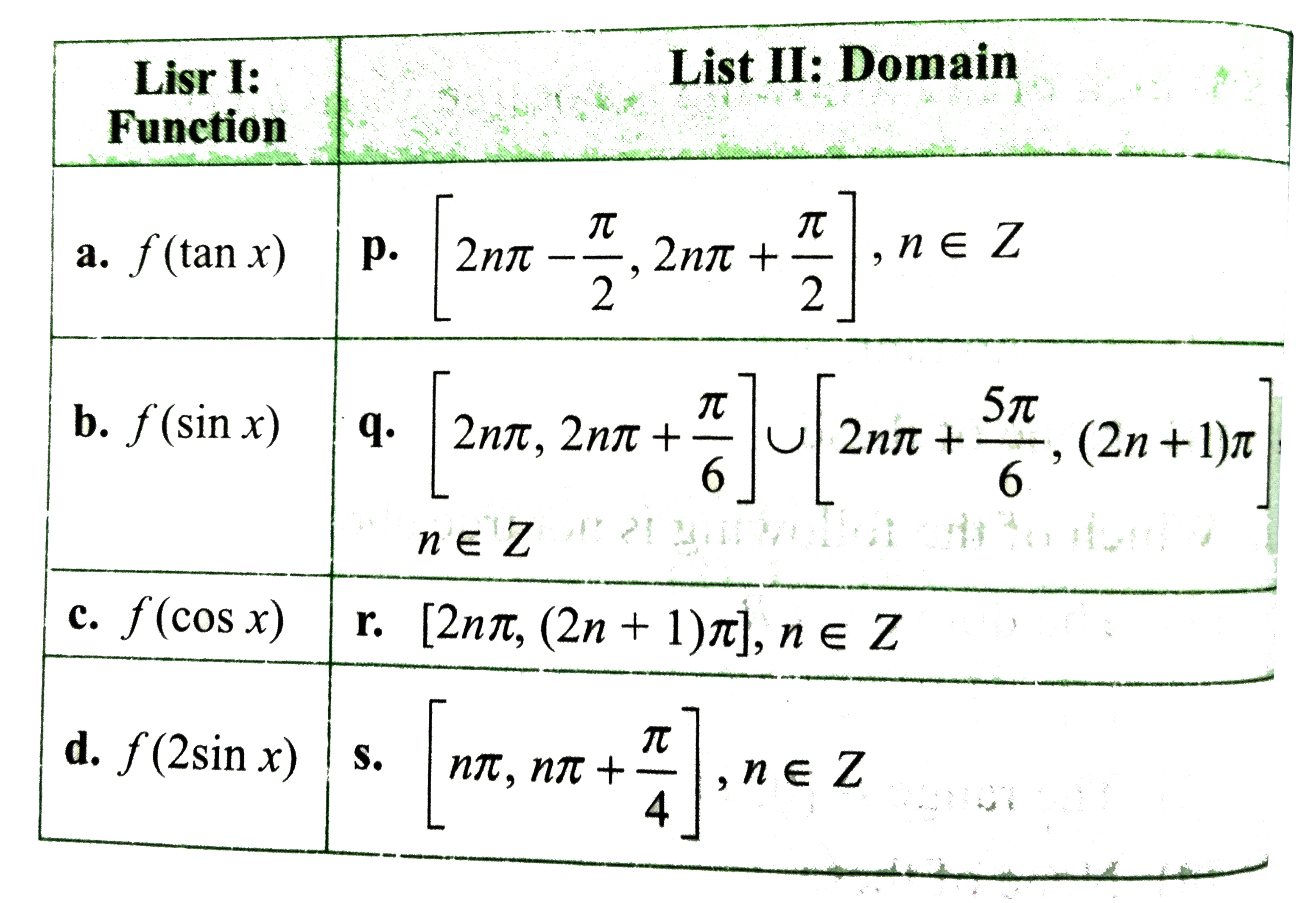Consider the function y=f(x) satisfying the condition f(x+1x)=x2+1/x2(x≠0). Then the a)domain of f(x)isR b)domain of f(x)isR−(−2,2) c)range of f(x)is[−2,∞] d)range of f(x)is(2,∞)Solution in Tamil
domain of f(x) is R
domain of f is R−(−2,2)
range of f(x) is [−2,∞)
range of f(x) is [2,∞)
The correct Answer is:B, D
f(x+1x)=x2+1x2
orf(x+1x)=x2+1x2=(x+1x)2−2
orf(y)=y2−2
Now, y=x+1x≥2or≤−2
Hence, the domain of the function is (−∞,−2]∪[2,∞).
Also, for these values of y,y2≥4ory2−2≥2.
Hence, the range of the function is [2,∞).
Topper's Solved these Questions
- BOOK - CENGAGECHAPTER - RELATIONS AND FUNCTIONSEXERCISE - Exercise (Comprehension)32videos
RELATIONS AND FUNCTIONS
- BOOK - CENGAGECHAPTER - RELATIONS AND FUNCTIONSEXERCISE - Exercise (Matrix)9videos
RELATIONS AND FUNCTIONS
- BOOK - CENGAGECHAPTER - RELATIONS AND FUNCTIONSEXERCISE - Exercise (Single)125videos
RELATIONS AND FUNCTIONS
- BOOK - CENGAGECHAPTER - Quadratic Equations, Inequalities, Modulus and LogarithmsEXERCISE - Question Bank28videos
Quadratic Equations, Inequalities, Modulus and Logarithms
- BOOK - CENGAGECHAPTER - SCALER TRIPLE PRODUCTS EXERCISE - DPP 2.311videos
SCALER TRIPLE PRODUCTS
Similar Questions
Consider the functions
f(x)={x+1,x≤12x+1,1<x≤2andg(x)={x2,−1≤x<2x+2,2≤x≤3
The domain of the function f(g(x)) is05:45View SolutionThe function f(x) is defined on the interval [0, 1]. Now, match the following lists:
 03:43View Solution
03:43View SolutionThe relation R={(1,1),(2,2),(3,3),(1,2),(2,3),(1,3)} on a set A={1, 2, 3} is
View SolutionLet a,b,c,d be positive integers such that (log)ab=32and(log)cd=54. If (a−c)=9, then find the value of (b−d).
03:07View SolutionNumber of integral value(s) of λ for which vectors x2ˆi−ˆj+xˆk,(λ−1)ˆi−2λˆj+ˆk and ˆi−ˆj+ˆk, in the order from right-handed system ∀x ∈R, is
02:40View SolutionConsider the function y=f(x) satisfying the condition f(x+1x)=x2+1/x2(x≠0). Then the domain of f(x)isR domain of f(x)isR−(−2,2) range of f(x)is[−2,∞] range of f(x)is(2,∞)
05:25View SolutionLet f(x)=(sqrt(x-2(sqrt(x-1))))/(sqrt(x-1)-1)x then: (a) f'(10)=1( b) f'((3)/(2))=-1( c) domain of f(x) is x>=1( d) range of f(x) is (-2,-1)uu[2,oo]
05:08View Solutionf:(−∞,0]→[0,∞] is defined as f(x) =x2 . The domain and range of its inverse is
02:28View SolutionIf a function satisfies the condition f(x+1/x)=x^(2)+1/(x^(2)),xne0 , then domain of f(x) is
02:23View SolutionConsider the real-valued function satisfying 2f(sinx)+f(cosx)=x. then the (a)domain of f(x)isR (b)domain of f(x)is[−1,1] (c)range of f(x) is [−2π3,π3] (d)range of f(x)isR
05:39View SolutionConsider the function y=f(x) satisfying the condition f(x+1x)=x2+1/x2(x≠0). Then the (a) domain of f(x)isR (b)domain of f(x)isR−(−2,2) (c)range of f(x)is[−2,∞] (d)range of f(x)is(2,∞)
05:18View SolutionLet f(x)=√x−2√x−1√x−1−1x. Then (a)f′(10)=1 (b)f′(32)=−1 (c)domain of f(x) is x ≥1 (d)range of f(x)is(−2,−1)∪(2,∞)
04:33View SolutionLet f be the function f(x)=cosx−(1−x22). Then (a) f(x) is an increasing function in (0,∞) (b) f(x) is a decreasing function in (−∞,∞) (c) f(x) is an increasing function in (−∞,∞) (d) f(x) is a decreasing function in (−∞,0)
05:19View SolutionConsider the real-valued function satisfying 2f(sinx)+f(cosx)=x. then the domain of f(x)isR domain of f(x)is[−1,1] range of f(x) is [−2π3,π3] range of f(x)isR
10:00View SolutionFind the domain and range of the following functions:
i)f(x)=1√x−5
ii) f(x)=x1+x2.05:21View SolutionIf domain of f(x) be (-1, 2), then
(1) domain of f(sin x) will be (−∞,∞)
(2) domain of f(ln x) will be (1e,e2)
(3) domain of f(2x-3) will be (1,5/2)
(4) domain of f([x]) will be [0, 2), where [x]≤x08:05View Solution

